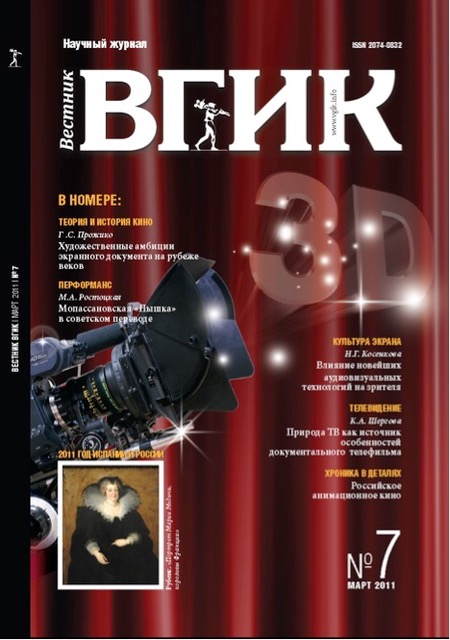Том 3, № 1 (2011)
- Год: 2011
- Статей: 14
- URL: https://journals.eco-vector.com/2074-0832/issue/view/899
- DOI: https://doi.org/10.17816/VGIK31
Статьи
Влияние новейших аудиовизуальных технологий на зрителя
Аннотация
Статья посвящена проблеме воздействия современных технологий, используемых в кино, на зрителя. Рассматриваются вопросы формирования визуальной культуры и влияния на этот процесс технологий, а также расширения сферы «видимого» для современного человека, включения в нее новых, необычных объектов, возникающих на пересечении гиперреального и фантастического.
Вестник ВГИК. 2011;3(1):80-88
 80-88
80-88


В Эрмитаже - Прадо
Вестник ВГИК. 2011;3(1):134-134
 134-134
134-134


Российское анимационное кино
Аннотация
Краткая версия исследования «Российское анимационное кино», проведенного независимой исследовательской компанией Movie Research (MRC) в период с октября по декабрь 2010 года в интересах органов государственного регулирования и основных участников отрасли.
Исследование построено на методе глубинных интервью и систематизирует мнения 15 видных представителей анимационной отрасли, среди которых: Лев Бубненков («Пилот»), Георгий Васильев (ПЦ «Аэроплан»), Александр Герасимов («Студия «Мастер-фильм»), Арсен Готлиб («МетрономФильм»), Дмитрий Ловейко («Анимаккорд»), Иван Максимов, мультипликатор, Павел Мунтян (Toonbox), Дмитрий Наумов (ТПМ) и Илья Попов (ГК «Рикки»).
Вестник ВГИК. 2011;3(1):150-154
 150-154
150-154


ТЕОРИЯ И ИСТОРИЯ КИНО | ЭКРАННЫЕ ИСКУССТВА
Фильм А. Звягинцева «Изгнание» и традиция трансцендентального кино
Аннотация
Данная работа (начало статьи в № 6) посвящена исследованию языковой системы фильма «Изгнание» режиссера А. Звягинцева в ракурсе трансцендентального кино. Основная задача, которую ставит перед собой автор статьи: выявить и эксплицировать то, каким образом структура фильма, его специфический язык манифестируют трансцендентное.
Вестник ВГИК. 2011;3(1):6-16
 6-16
6-16


КИНОЯЗЫК И ВРЕМЯ | ГЕНЕЗИС ОБРАЗА
Эллинистическая перестройка. Эпикуреизм и образные отклонения
Аннотация
В статье анализируется образность последнего периода античности - эллинизма, масштабная социально-политическая и пластическая перестройка которой привели к переменам в образном функционировании. Образ становится гигантом или, напротив, выражает себя в субтильной и интимной фигуре, включается в персональное восприятие, а с началом процесса своего тиражирования - объектом будничного восприятия. Особое внимание в работе уделяется образной концепции Эпикура.
Вестник ВГИК. 2011;3(1):18-24
 18-24
18-24


Художественные амбиции экранного документа на рубеже веков
Аннотация
Статья рассматривает особое направление в мировой документалистике рубежа XX и XXI веков - художественный авторский фильм на примере творчества ведущих мастеров К. Маркера, В. Херцога, Г. Реджио, В. Вендерса. Текст является частью большого исследования, посвященного истории зарубежного документального кино.
Вестник ВГИК. 2011;3(1):25-43
 25-43
25-43


Ситуации и герои довоенного американского кино
Аннотация
Работа посвящена исследованию популярных драматических коллизий, на основании которых делаются выводы о психологической истории довоенного американского кино. Наряду с анализом 50-ти самых кассовых фильмов Америки 1930-х годов в статье рассматриваются популярные сюжеты и типы киногероев. В настоящем исследовании, впервые в киноведении, применяется метод частотного анализа.
Вестник ВГИК. 2011;3(1):44-56
 44-56
44-56


ПЕРФОРМАНС | ИСКУССТВО ВОПЛОЩЕНИЯ
Мопассановская «Пышка» в советском переводе. К 110-летию со дня рождения М.И.Ромма
Аннотация
Статья публикуется к 110-летию со дня рождения М.И. Ромма. Анализируя режиссерский дебют в кино выдающегося советского режиссера - фильм «Пышка», автор показывает, как трансформировались смыслы мопассановского произведения в определенном историко-социальном и мировоззренческом контексте, как отразились в картине не только идеологические штампы эпохи, но и мудрая проницательность режиссера, всю жизнь развивавшего в себе остроту видения, чувство времени.
Вестник ВГИК. 2011;3(1):58-66
 58-66
58-66


Конфликт «внутреннего» и «внешнего» человека как архетипическая тема киноискусства
Аннотация
Конфликт «внутреннего» и «внешнего» человека, столь важный для новозаветной парадигмы, осмыслен киноискусством на уровне многих антиномий. Пожалуй, самой продуктивной из них является противоречие между реальностью и игрой. Реальность, в свете трагического конфликта «внутреннего» и «внешнего» человека, ассоциируется с подлинным бытием, со всей глубиной бытия, а игра ассоциируется с побегом от подлинности, с моделями мнимого существования.
Вестник ВГИК. 2011;3(1):67-77
 67-77
67-77


МИРОВОЙ КИНОПРОЦЕСС | АНАЛИЗ
Новое «лирическое сознание» Гийома Аполлинера и «лирическая правда» Луи Деллюка
Аннотация
Статья посвящена периоду формирования первой волны французского киноавангарда («киноимпрессионизма»). В работе рассматривается влияние, оказанное одним из крупнейших французских поэтов XX века Гийомом Аполлинером на теоретическую концепцию видного теоретика и практика киноавангарда Луи Деллюка. В частности, анализируется родственность концепций нового «лирического сознания» Г. Аполлинера и «лирической правды» Л. Деллюка.
Вестник ВГИК. 2011;3(1):90-101
 90-101
90-101


ТЕЛЕВИДЕНИЕ | ЦИФРОВАЯ СРЕДА
Природа ТВ как источник особенностей документального телефильма
Аннотация
В статье раскрывается влияние некоторых черт телевидения на жанры документального кино. Особенности ТВ как наиболее массового медиа налагают на телефильм требования, типичные для всего телевизионного контента. Особое внимание уделяется специфике восприятия телерассказа, рассматриваемой в историческом аспекте.
Вестник ВГИК. 2011;3(1):104-112
 104-112
104-112


Реальное телевидение как фактор социокультурной глобализации
Аннотация
Вторжение цифровых и компьютерных технологий в сферу телевидения, активно формирующаяся цифровая среда стимулируют производителей аудиовизуальной продукции к поиску новых форм репрезентации телевизионного контента. В статье анализируется один из наиболее провокативных телевизионных форматов - Reality, нередко называемый авангардистским, который переживает свое второе рождение в новом содержательном качестве. Ставится проблема приближения эры реального телевидения.
Вестник ВГИК. 2011;3(1):113-122
 113-122
113-122


АЛГОРИТМ НАУКИ | МЕТОДОЛОГИЯ ПОГРУЖЕНИЯ
К вопросу о методологии научного исследования
Аннотация
Требования к подготовке и оформлению диссертаций меняются каждый год, в зависимости от внутренней реорганизации Всероссийской Аттестационной комиссии. Неизменным остается одно: организация ума, структуры и логики диссертации, а также некоторые психологические навыки самого соискателя. Статья знакомит с нелегкой «лествицей» соискательства, что способствует продуктивному осознанию этого тернистого пути.
Вестник ВГИК. 2011;3(1):136-149
 136-149
136-149


НАУЧНАЯ ЛАБОРАТОРИЯ | ЦВЕТ В КИНО
Аксиология исторической дихотомии политической «окраски» отечественного экранного контента
Аннотация
Статья посвящена анализу образа противостояния политических сил в истории России XX века, которое нашло свое отражение в отечественной экранной продукции. Проблема отношений между «красными» и «белыми» рассматривается автором на примере фильмов и сериалов с точки зрения ценностных ориентиров враждующих общественных сил.
Вестник ВГИК. 2011;3(1):124-133
 124-133
124-133













